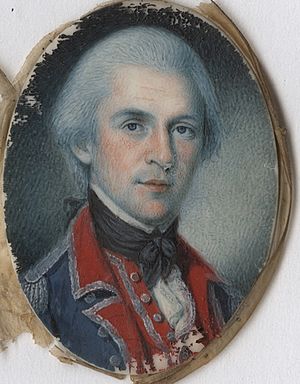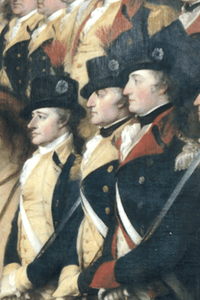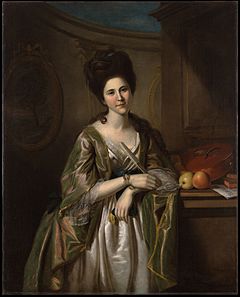Walter Stewart (general) facts for kids
Quick facts for kids
General Walter Stewart
|
|
|---|---|

Walter Stewart, miniature portrait by Charles Willson Peale, 1781
|
|
| Personal details | |
| Born | 1756 Derry, Northern Ireland |
| Died | June 16, 1796 Philadelphia, Pennsylvania |
| Spouse | Deborah McClenachan |
| Children | 8 |
| Military service | |
| Allegiance | United States |
| Branch/service | Infantry |
| Years of service | 1776–1783 |
| Rank | Brevet Brigadier General, Continental Army Major General, Militia |
| Battles/wars | American Revolutionary War |
Walter Stewart (born 1756 – died June 16, 1796) was an important American general during the American Revolutionary War. He was born in Ireland and became a key leader in the Continental Army, which fought for America's independence.
Stewart started his military journey as a captain in Pennsylvania. He quickly rose through the ranks, serving as an assistant to General Horatio Gates. He bravely led his troops in major battles like Brandywine and Germantown. Even after being wounded, he continued to serve with courage. After the war, he became a successful businessman and a general in the state militia.
Walter Stewart's Early Life
Walter Stewart was born in 1756 in Ireland, likely in a place called Londonderry. When he was about 16 years old, around 1772, he moved to Philadelphia, Pennsylvania. There, he started working for a relative named Conyngham.
Stewart's Military Career
Starting as a Soldier
In January 1776, Walter Stewart became a captain in the 3rd Pennsylvania Battalion. This group of soldiers was formed in Philadelphia and joined George Washington's main army later that year. By May, Stewart was promoted to major and became an aide-de-camp (a personal assistant) to General Horatio Gates.
Stewart was well-liked and known for his good looks. People in Philadelphia even called him the "Irish Beauty." One person said he was "the handsomest man in the American army." In June 1777, Stewart was given command of the Pennsylvania State Regiment, which later became the 13th Pennsylvania Regiment.
Stewart supported General Gates in his disagreements with another general, Philip Schuyler. He wrote to Gates, showing how happy he was when Gates returned to his command.
Fighting in the Philadelphia Campaign

At the Battle of Brandywine on September 11, 1777, Stewart's Pennsylvania State Regiment fought bravely. General Washington's army of 11,000 soldiers faced British General Sir William Howe's 12,500 troops. The British tried to sneak around the American side, leading to a tough fight.
Stewart's regiment was part of George Weedon's Brigade. They set up behind a fence and in some woods, ready to surprise the British. As evening fell, a British group walked right into their trap. Stewart's men fired heavily, causing many British soldiers to fall. One person remembered Stewart "on foot, in its rear, animating his men." An officer in his regiment said they fought for about an hour under constant fire. The British eventually pushed them back, but the Americans fought hard.
Stewart also led his soldiers at the Battle of Germantown on October 4, 1777. His unit helped protect the left side of the American attack. They successfully captured a small fort with three cannons. Stewart wrote that it was "cursed Hot work" before the British left. He noted that his men fought deep into the British lines. Later, on November 12, 1777, his regiment was renamed the 13th Pennsylvania Regiment.
The Battle of Monmouth
In June 1778, the British army left Philadelphia and marched towards New York. General Washington moved his army to stop them. On June 28, the Battle of Monmouth began. General Charles Lee (general) led the American advance troops.
Stewart was part of a group led by General Anthony Wayne. When the battle started, Lee's troops began to retreat in some confusion. Washington arrived and quickly took charge, trying to stop the British advance. Washington asked Stewart and another officer, Nathaniel Ramsey, to hold off the British in a thick wood. They agreed.
As British soldiers entered the woods, Stewart's and Ramsey's men fired at them, causing many casualties. However, the British Guards and Grenadiers were strong. Early in this intense fight, Stewart was shot and had to be carried away. The Americans were eventually pushed back, but their brave stand gave Washington time to set up his main army.
Leading the 2nd Pennsylvania Regiment

On July 1, 1778, Stewart took command of the 2nd Pennsylvania Regiment. He was known for taking good care of his soldiers, which made them respect him.
In 1780, when some soldiers from Connecticut rebelled in New Jersey, Stewart's Pennsylvania regiment helped restore order. Stewart and other Pennsylvanians talked to the unhappy soldiers, assuring them that their problems were understood.
However, Stewart's own regiment later joined the Pennsylvania Line Mutiny on January 1, 1781. Soldiers were angry about not being paid and other issues. They marched towards Philadelphia, ignoring their officers. Three officers were killed. The soldiers eventually negotiated with Congress and received some of what they demanded. After this, the Pennsylvania Line was reorganized, and Stewart was given command of a new fighting unit.
Green Spring and Yorktown Battles
On July 6, 1781, Stewart led a Pennsylvania battalion at the Battle of Green Spring. His troops were part of General Wayne's advance group. They walked into a British trap, being outnumbered seven to one. General Wayne bravely ordered a counterattack, which allowed the Americans to escape with fewer losses.
In October 1781, Stewart took part in the important Siege of Yorktown. This was a major victory for the Americans, leading to the British surrender. Stewart commanded the 1st Pennsylvania Battalion in this battle.
The Newburgh Conspiracy
Stewart officially left the army on January 1, 1783. However, General Washington asked him to stay on as the Inspector General for the Northern Department. Around this time, Stewart became involved in something called the Newburgh Conspiracy.
By the winter of 1782–1783, the war was almost over. Many Continental Army officers were worried because Congress had promised them a pension (half-pay for life) but hadn't kept the promise. The officers felt they needed to get their back pay before the army was disbanded.
In January 1783, a group of officers sent a petition to Congress. Washington agreed that the officers' concerns were fair. However, Congress voted against giving them full pay for five years instead of the pension. Washington was worried about a large-scale rebellion by the army.
When Walter Stewart arrived at Newburgh, some officers asked him to talk to Washington. They hoped to convince Washington to support their idea of keeping the Continental Army as a permanent force. They believed that without the army, they would lose their respect and face difficulties as civilians.
Stewart felt Washington didn't agree with this plan. So, he turned to General Horatio Gates, his former commander, who was more sympathetic. Some historians believe Stewart was a key person behind the Newburgh Conspiracy. He warned officers that Congress might disband the army to avoid paying them. He urged them to stand together and demand their pay immediately.
The situation became very tense on March 10, 1783, when the first "Newburgh Address" was published. This message encouraged the army to take action against Congress.
Washington acted quickly to prevent a mutiny. He called a meeting of officers on March 15. He also told Congress they needed to address the army's concerns soon. At the meeting, Washington gave a powerful speech. He asked his officers not to do anything that would "lessen the dignity and sully the glory you have hitherto maintained." He then took out his spectacles to read a letter, saying, "Gentlemen, you must pardon me. I have grown gray in your service and now find myself growing blind." This moment deeply moved many officers. The officers then voted to trust Congress and rejected the ideas in the Newburgh Addresses. On March 22, Congress voted to approve a compensation plan, which the officers accepted.
Life After the War
In 1783, Stewart finally retired from the army with the honorary rank of brigadier general. He settled in Philadelphia, living across the street from George and Martha Washington. He became a very successful businessman and a major general in the state militia.
Walter Stewart died on June 16, 1796, during a serious outbreak of yellow fever in Philadelphia. He was buried in the Old St. Paul's Episcopal Church burial ground.
Walter Stewart's Family Life
On April 11, 1781, before the British surrendered at Yorktown, Walter Stewart married Deborah McClenachan. She was 17 years old and the oldest daughter of a Philadelphia businessman named Blair McClenachan. Her father was known for helping to start the First Troop Philadelphia City Cavalry. He also bought a house called Cliveden, which had been badly damaged during the Battle of Germantown.
Walter and Deborah Stewart had eight children together. Two of their children were born while they were living abroad, one in Ireland and one in England. Their children were:
- William Stewart (1781–1808), who died at sea.
- Robert Stewart (1784–1806).
- Ann Mathilda Stewart (1786–1865), who married Philip Church.
- Walter Stewart (1787–1807).
- Henry Stewart (1788–1823).
- Mary Ann Stewart (1791–1844).
- Caroline Stewart, who died as a baby.
- Washington Stewart (1796–1826), who was born two months after his father passed away.


